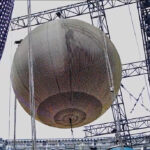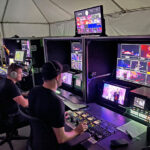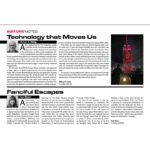
Creating a Video Avatar of the Queen for her Platinum Jubilee Pageant
Marking the 70th year of Queen Elizabeth II’s reign, having ascended to the throne in February of 1952, the Queen’s Platinum Jubilee celebrations were full of pageantry, parades, balcony waves, and, of course, splendid coaches. Among the highlights of the revelry was the Platinum Jubilee Pageant appearance of the 260-year-old Coronation Gold State Coach. Though it had not left its home in the Royal Mews at Buckingham Palace for 20-years, being the very same coach that Queen rode in on her coronation day on June 2, 1953, its inclusion in the Jubilee seemed an obvious decision. The only problem is that the Coach is a notoriously rough ride and having the beloved 96-year-old Queen ride in the coach was not going to happen. So rather than have the empty coach in the Pageant, Nicholas Coleridge, co-chair of the Pageant, had an idea for a bit of Royal magic. He wanted to see if there was a way that as the Gold State Coach passed by the crowds, they could still catch a glimpse of Her Majesty—not as she is today but as the 27-year-old Queen on her Coronation Day.
To realize this wonderful vision, the Pageant committee contacted Treatment Studio, London. The brief was to create some kind of avatar-like illusion that would place the young Queen inside the historic coach as it made its journey along the procession of the Pageant route. Treatment has created visual spectacles for some of the world’s largest events and concert tours (including the projections on Buckingham Palace for the Queen’s Diamond Jubilee in 2012) but this combination of technology and history was an entirely new and truly unique challenge. “Initially we were all terrified of the Coach itself,” says Lizzie Pocock, Producer at Treatment, “The fear of damaging this priceless, irreplaceable object was overwhelming at first, but the Palace staff were all extremely helpful and went out of their way to put us at our ease.”
Willie Williams, Director at Treatment Studio, adds, “The thought of working with this incredibly old and famous object was just too tempting, so that’s where we started. The Palace people were very good. There are the people that have the important roles that liaise directly with the Royal family, as well as the other team, who I was calling the roadies, who do the day-to-day work, and actually physically look after all this stuff. They were both great in their own ways, and super, super helpful. One of them said, ‘Look, the thing is, the Crown wants this. They know about it, and they want it to happen. So therefore, it’s just our job to deliver it.’ Obviously, on one level they’re very protective of looking after everything, as you’d expect, but they aren’t precious about them, because they know they’re custodians of these things. So, that was incredibly helpful.”
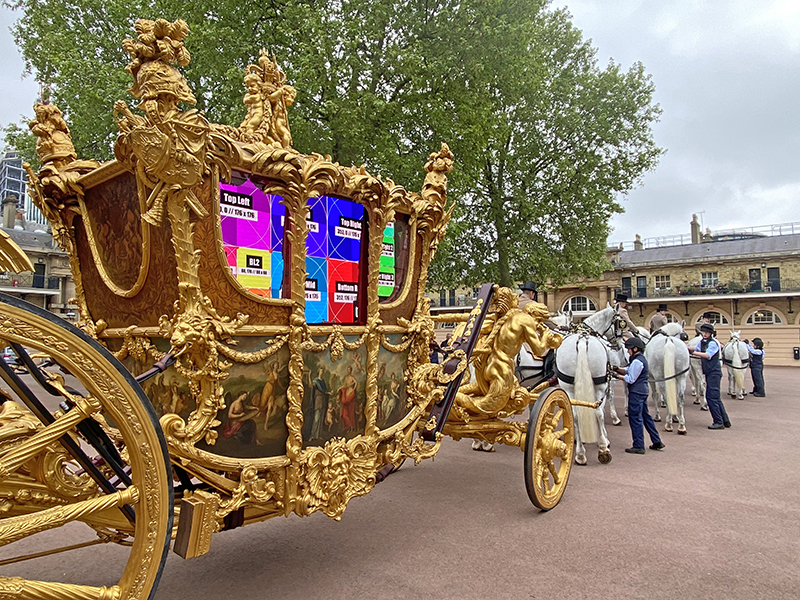
Creating Footage of the Queen
While part of the team at Treatment was tasked with starting the planning for the playback and logistics of getting the video gear into the coach, others at Treatment needed to address the content itself. The 1953 Coronation was shot on film by newsreel cameras but creating the illusion for the Platinum Jubilee was far more complex than simply using the historic footage. Treatment determined they would need to undertake the arduous work of literally creating the required video clip. “We were told that they could give us footage from 1953 of her, after her Coronation returning to the palace,” states Pocock, “but that the footage was ‘very limited; very poor quality.’ Also, the coach was always moving. So, actual footage of her inside the coach that was clean enough and steady enough for us to use was extremely limited. Even though the footage was shot 70 years ago, it was fortunately all shot on film. There is color footage from the day, but it wasn’t nearly the same quality as the black and white film, which was much crisper.”
“Very little of the original footage was suitable for what we needed,” agrees Williams and he explains, “We had to create new content of our own. We did a 4K transfer, but there’s just not enough footage of her in the coach. So, there were many hours of trolling through footage from the Coronation Day to try and find tiny snippets of stuff that could work. We actually had to make our own footage; the footage that we’ve used is taken from three different clips of her actually on the balcony of the Palace later in the day, waving. Also, much of the original material was black and white, so this had to be painstakingly colorized. We eventually rotoscoped and composited pieces together; recolored and graded to make the final piece of video of her sitting and waving inside of the Coach. Brandon Kramer, our editor, created the whole piece by compositing and manipulating footage from multiple sources to make believable images of the young Queen as she was at her Coronation. In the end we came up with a 20-second loop which we felt was enough for the passage of the Coach; at the speed it would travel during the Jubilee. I don’t think anybody actually saw it loop. It was an awful lot of work for what ended up being a 20-second clip.”
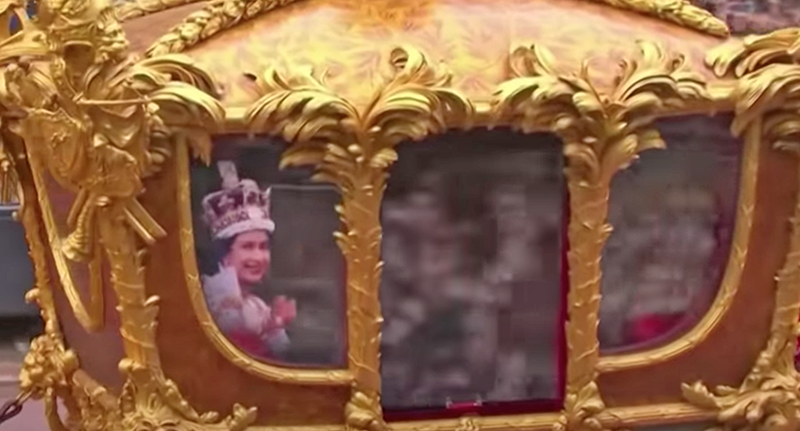
Building Out the Team
For the display and playback technology, Williams turned to a long-time colleague, Frederic Opsomer, CEO of PRG Projects, a division of Production Resource Group. Some of Opsomer’s milestones include creations for U2’s PopMart and 360˚ tours as well as the London Olympic Ceremonies. Williams felt he was the right person for a project of this unique and custom nature. “I’ve had such a long relationship with Frederic, that I knew he was the right person for this,” notes Williams. “He really understands the way I work, and he would be able to completely second-guess what would be important and what wouldn’t in a project like this. It was just one of those times where I knew this was a perfect Frederic/PRG project, because it was so unusual; and he knows how my brain works, really.”
Williams continues, “The scarcity of gear, and the short lead time, in a way also helped us cut to the chase, because we didn’t have the myriad options that we might have had otherwise. Certainly, there was going to be no time to get anything specially fabricated in terms of a screen. There was just no time now that we live in a post-Covid world. PRG completely delivered and Frederic was very helpful with sourcing everything we needed in terms of the screen and playback systems.”
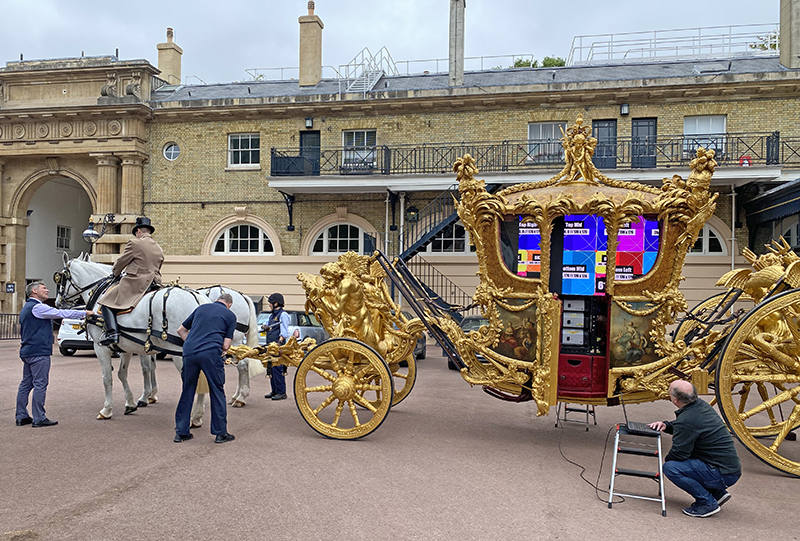
Building a High-Tech Ship in a Bottle
Opsomer, who had been playing with an idea for a new LED frame system, had built some prototypes and was developing it into a real, flexible, and reusable platform when this project came along. The timing was ideal as this would be the right project to deploy this new LED frame platform. “We built a modular structure, that’s 100% recyclable, that we developed during the pandemic,” describes Opsomer. “Obviously, we could not make any holes in the carriage, instead we made it so that we could actually force the structure against the lower chassis of the carriage. The Palace Conservators took out the carpet, so the frame sat right on the floor, but with adjustable pressure rods that were positioned so that it would not start shaking and moving. That modular structure contained seven 2mm LED products on each of the two sides of the frame.” After much testing of different pixel pitches, it was decided to go with a 2mm pitch product. The team chose to use stock ROE Visual Black Onyx LED panels with Brompton Technology’s 4K Tessera SX40 LED processor. To power the video system, which would need to be battery-powered for the 45-minute or so length of the Pageant route, Opsomer selected batteries from the Netherlands-based Wattsun.
“The thing about it,” says Williams, “is it’s a very rough ride in there, and no video equipment had ever been treated like that. It’s like taking an entire video station from a gig and picking it up and shaking it. Of course, no one’s really ever done that before, so we had to make sure that was okay. Extensive testing and rehearsals continued throughout the process to ensure that all the video equipment would continue to function in the rather sea-sick conditions of the coach.”
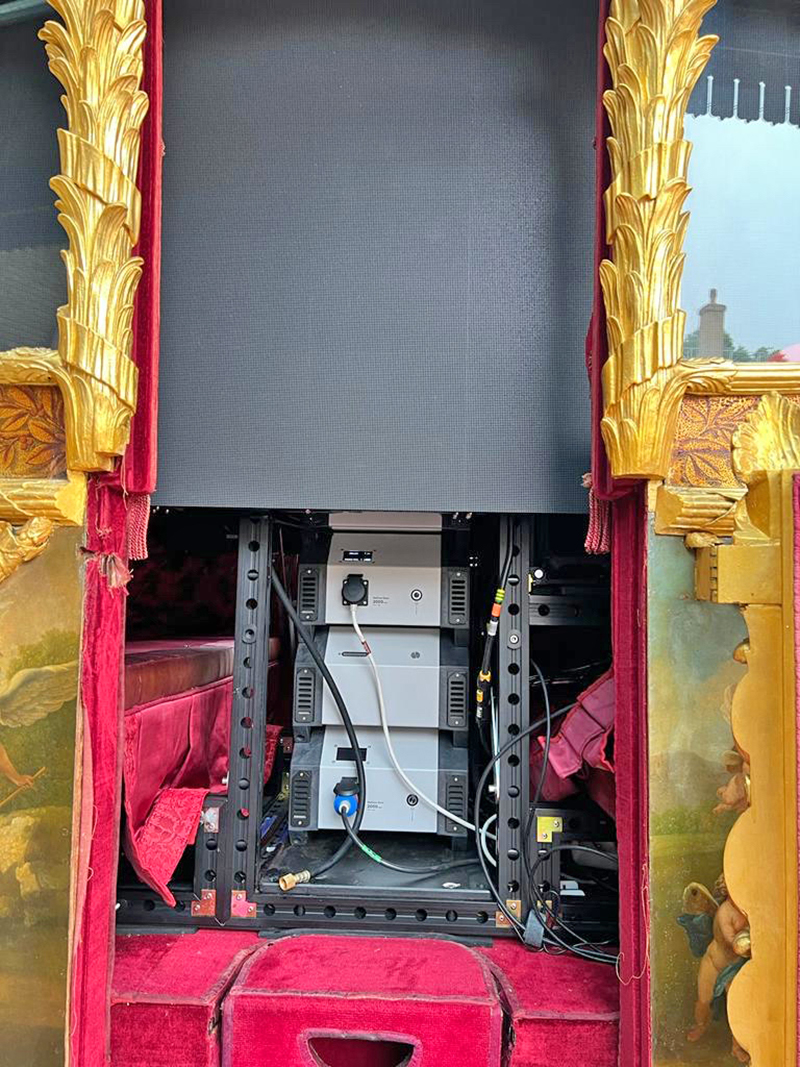
For testing the stability of the video system to stand up to the jostling and jarring moves, Opsomer and his team built a mockup of the system in Antwerp. “We did a full mockup with a replica of the carriage and the structure inside,” Opsomer explains. “We had files for the measurements on the inside of the carriage because someone had done a full scan of it. We made a structure based on those files. We did a full shake test in Belgium to see that everything was stable, then disassembled the system and rebuilt it in the UK, inside the actual carriage.”
The steel framework was fabricated, and with the help of the Palace Conservators was assembled inside the coach at the Palace. Onto this framework, the video equipment would be secured without touching the antique red silk interior. “The internal space of the coach is small, and the doors are tiny, so the process often felt like assembling a high-tech ship in a bottle,” says Williams. “The biggest challenge, I think, was protecting the Coach. The interior is red silk—and even though it’s not original, it was last upholstered in 1902, so it’s 120-years-old! It’s just very fragile.” To protect the carriage from fire, the team added a CO2 pressurized tank inside. “So, whilst the carriage was driving around, we had CO2 inside the carriage,” notes Opsomer. “So that in case something would go wrong, there could not be any fire inside.”

Weight Control
Before the team even got to the stability test, they first needed to figure out how much weight the coach could support. “One of the very first tests we did were weight tests, literally using stage weights, and driving around the Buckingham Palace Mews,” recalls Williams. “They’d drive the coach around in a fairly large circle. So, the first proper test day, we were just loading stage weights into it incrementally, to make sure that it was going to be able to take the weight of all the equipment. It only ever, historically, takes two people at a time. And I mean, the Queen’s tiny, so there hadn’t really been that much weight in it.”
Williams points out, “Of course, to make this thing move, you need horses, and so everything we needed to do with a movement test, they had to bring horses in. With that, you get the Queen’s Equerry, and you get the Coachmen, and the Postilion. So, all these people arrive with the horses so that we could do the testing, each time.” The Treatment team worked with a team of eight horses to test all of the required movements, during the weeks prior to the Jubilee. This included practicing an emergency stop as well as setting up cable ramps around the Palace Mews to replicate conditions the coach would face on the day.
“So, we did all that testing and realized that we were okay weight-wise,” comments Williams. However, they also realized that there would be no room—or weight allowance—for a technician/operator on board, so a custom system was developed by Treatment’s Mike Smith to control the playback wirelessly via the Internet, as it travelled the Pageant route. A simple solution for the playback, a BrightSign Media Player from Houston, TX-based OptiSign, Inc. that normally supports the digital signage market. “We chose that media player because we didn’t need a lot of memory capacity; it was only a 20-second clip that repeated,” says Opsomer. “The possibility to control it from a distance was more important for this media server. We remotely controlled the whole system over Wi-Fi. We could actually control the video screen, the media server, and the batteries from one central location. There was a technician sitting in the Royal Mews in front of a bunch of computers, actually controlling the screens from a distance. This was in case something would happen; we would have had the possibility to intervene with the system.” With the need for the remote control, this project has left an unexpected legacy for future occupants of the Coach. Mike Smith, from Treatment, who conceived the playback system, quipped “after 260-years, the Gold State Coach has finally been fitted with onboard Wi-Fi!”
One last fail-safe was to also have someone walking with the Coach itself, so one of the Treatment techs was dressed as a Coachman and got to walk alongside the Coach throughout the procession. “It was a simple solution and it was certainly quite a moment for him,” comments Pocock. “He walked the route behind the carriage and then we had a spotter on route that right before the coach got to the Mall, where the BBC cameras would be picking up the coach; they let us know that everything was okay.”

A High-Tech Gold State Coach Leaves the Mews
A final morning rehearsal was held at 4am to take the Coach and its high-tech cargo around the full route of the Pageant. The rehearsal went well and, on the day, the image of a 27-year-old Queen waving to the gathered crowds in the Coronation Gold State Coach travelled modern day London for everyone to see. The final clip even included some faintly “reflected” crowds in the coach windows to make it appear more lifelike in the moment. The combination of technology and history was unprecedented and created an unforgettable experience and image to which the gathered crowds even waved back.
When asked what it meant for Treatment Studio to be selected for this historic assignment, Pocock says, “It’s one of those projects, and one of those days, that you just never forget. It was an honor really to be part of it. And an honor in many respects to work with the team at the Mews and have a little sneak peek behind the scenes of what goes on, which was kind of magical; very special memories.”
Williams concludes that “We were very happy with being involved—obviously the Jubilee was a huge, huge event—but it was very nice to have this one very special, very eccentric part of it, without having to worry about all the rest of the stuff. It was a really interesting thing to do, getting to work with the wonderful people at the Palace, working with parameters that are completely different to anything we’ve worked in before. You don’t often get that kind of a challenge, to do something so completely different, and that was really exciting to do. “
From Opsomers’ point of view, he recalls in the beginning he thought about this project on a technical level. “’Okay, this can be done. Let’s do this.’ But during the project, I started to understand the emotional importance for so many people. That made it so unique. With PRG, we’ve done big shows, Olympics, and big concerts, but this one was very unique because it touches the heart of so many people around the globe. That, for me, was very unique. I really understood it when I was on a British Airways plane and one of the movies was a documentary on the 1953 Coronation, in color. Seventy years ago, with the introduction of television, there were a lot of questions like, ‘Shall we actually televise the Coronation?’. There were a lot of new technologies being installed, new procedures, and then you suddenly realize, what we were doing today with the Coach is maybe, on a very small scale, a little bit similar to what happened 70 years ago.”
